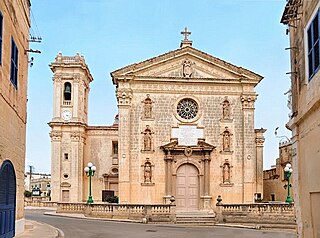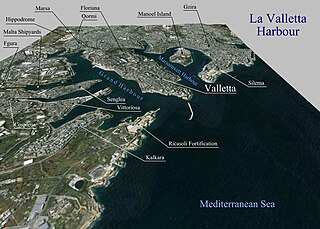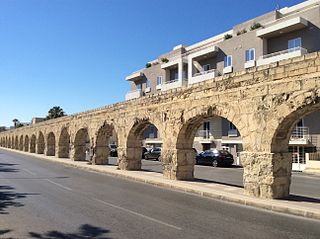
Attard is a town in the Central Region of Malta. Together with Balzan and Lija it forms part of "the Three Villages" and has been inhabited since the Classical Period. It has a population of 10,650 as of March 2014. Attard's traditional Latin motto is Florigera rosis halo due to its many flower gardens and citrus orchards. Attard is abundant with public gardens. The inhabitants of Attard are known as saraċini.

Birkirkara is a town in the central region of Malta. It is the second most populous on the island, with 24,356 inhabitants as of 2020. The town consists of five autonomous parishes: Saint Helen, Saint Joseph the Worker, Our Lady of Mount Carmel, Saint Mary and San Gorg Preca. The city's motto is In hoc signo vinces, and its coat of arms is a plain red cross, surmounted by a crown.

Balzan is a municipality in the Central Region of Malta, one of the so-called three villages, together with Attard and Lija. The village originally consisted of a group of small dwellings and farms but eventually grew, becoming a parish in the 17th century. As at 2019 the town had 4768 inhabitants.

Qormi, also known by its title Città Pinto, is a city in the Southern Region of Malta, located southwest of Valletta in the centre of the island. It has a population of 16,324, which makes it the fifth largest locality in Malta.

The Grand Harbour, also known as the Port of Valletta, is a natural harbour on the island of Malta. It has been substantially modified over the years with extensive docks, wharves, and fortifications.
Joseph Attard Kingswell (1925–2002) was a Maltese trade unionist and diplomat. He served as General Secretary to the General Workers Union, the largest trade union in Malta; as well as being the Ambassador for Malta in Belgium and the Ambassador Extraordinary in Norway. He was also the editor of It-Torċa, a newspaper issued by the union, from 1958 to 1967. He travelled abroad on international assignments by the International Confederation of Free Trade Unions from 1959.

Maltese architecture has its origins in prehistory, and some of the oldest free-standing structures on Earth – a series of megalithic temples – can be found on Malta. The islands were colonized by the Phoenicians and later the Romans, who established the cities of Melite and Gaulos. Although these were substantial settlements and are known to have had numerous temples, churches and palaces, few remains have survived apart from some architectural fragments.
Donat Spiteri was to Spiridione and Antonia née Cassar

Malta is subdivided in districts of localities in order to administer the country in regions rather than locality. The districts have no administrative significance as the local councils provide the first-tier divisions of the country.
Tommaso Dingli was a Maltese architect and sculptor. One of the last Renaissance architects on the island, he designed several parish churches, most notably those of Attard and Birkirkara.

Many factories in Malta are located in one of the several industrial estates throughout the island. Malta Industrial Parks is a company which was created to manage industrial estates in Malta.

In the small Mediterranean island nation of Malta the predominant religion is Roman Catholicism.

In Malta most of the main roads are in the outskirts of the localities to connect one urban area with another urban area. The most important roads are those that connect the south of the island with the northern part, like Tal-Barrani Road, Aldo Moro Street in Marsa and Birkirkara Bypass.
The 2012–13 Maltese Third Division began on 16 September 2012 and ended on 5 May 2013.

The Wignacourt Aqueduct is a 17th-century aqueduct in Malta, which was built by the Order of Saint John to carry water from springs in Dingli and Rabat to the newly built capital city Valletta. The aqueduct was carried through underground pipes and over arched viaducts across depressions in the ground.

Gaetano Pace Forno was a Maltese Archbishop who became the Bishop of Malta after his predecessor Archbishop Publio Maria dei Conti Sant tendered his resignation.

Giovanni Attard was a Maltese architect, military engineer and stone carver from the town of Lija. He is mostly known for his role in the construction of the Wignacourt Aqueduct between 1610 and 1615.

The Parish Church of Saint Mary is a Roman Catholic parish church in Attard, Malta, dedicated to the Assumption of Mary. Built between 1613 and 1624, the church is attributed to the architect Tommaso Dingli and it is regarded as the finest Renaissance church in Malta. It still retains its original design, with the exception of a belfry and two sacristies which were added in the 18th and 19th centuries.

The Basilica of the Nativity of Our Lady is a Roman Catholic parish church in Xagħra, Gozo, Malta, dedicated to the Nativity of Mary. The present building was constructed between 1815 and 1855, on the site of a smaller church which had been built in the 17th century. The dome was added in 1892. The church became a collegiate church in 1900, and a basilica in 1967.

The Parish Church of the Assumption of the Blessed Virgin Mary into Heaven is a Roman Catholic parish church in Żebbuġ, Gozo, Malta, dedicated to the Assumption of Mary. The present building was built between 1690 and 1726 on the site of an earlier church, and it was enlarged between 1938 and 1942. The church's interior was extensively decorated using locally-sourced travertine from cave deposits in the late 20th century.
















